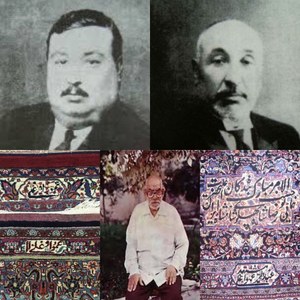What majority do not know about this ancient village:
1- This village is the only major silk weaving centre in Iran that produces its own silk, since ancient times.
2- King Naseredin shah of Qajar was born there.
3- Mr Muhammad Kahnamuie, or better known as Amu Oghli, was born there and he was a master silk weaver of the village.
Our article revolves around fact 3, Amu Oghli. He immigrated to Mashad in Khorasan around 1835 and was one of the senior Azari people in Mashad. Out of respect everyone called him Amu Oghli (translating to ‘big cousin’) and he chose that as his new surname. He started making and selling carpets in Mashad and soon his two sons, Mr Abdul Muhamad Amu Oghli (1872-1938) and Mr Alikhan Amu Oghli (1893-1958) and lesser known godson Mr Musa Amu Oghli, joined him to establish one of the best names in the Persian carpet workshop industry. The brothers visited England to view some of the Safavid carpets available there to get inspiration for designs and they made a replica of Ardebil carpet at the V&A Museum afterwards. They also bought a book on Safavid carpets that provided more inspiration for designs and they ordered Mr Abdul Hamid Sanaat Negar (a young designer from Kerman with talent out of this world, employed by the company) to alter the designs to suit the tastes of the new era.
Mr Abdul Muhamad Amu Oghli established workshops in Mashad,Dorokhsh,Muhammad abad (his manager was Mr Khalil Khadivi) and Torghabeh. Many carpets produced in these workshops had the Amu Oghli signature on top. His brother, Mr Alikhan, had his workshops in Shandiz and Golmakan with the signature, Alikhan Amu Oghli 110, at the bottom of his carpets. His workshops were closed for 6 years between 1948-1954 and he died while he was still finishing a carpet ordered by parliament of the time. His son, Mr Changiz Amu Oghli, carried on his legacy with a different signature.
These workshops got orders from so many wealthy families in Mashad, such as Mr Kuze Kanani (super wealthy tobacco tycoon of Mashad with a design attributed to him), that it resulted in their soaring popularity and eventually the royal palaces started ordering from them as well. Reza Shah Pahlavi was in love with this family and he ordered so many master pieces from them and his son, Muhammad Reza Shah, followed suit.
The name Amu Oghli gave life to Mashadi carpets and many workshops after them cashed in on their fame and style. To understand the signatures of Amu Oghli one need to know each single style of weaving (including colour choices and fineness, eg. usually carpets from Mr Abdul Muhammad are the finest even up to 150 raj) of the father, the two sons, the one godson and the all grandchildren’s workshops (and obviously the copies made too)!



